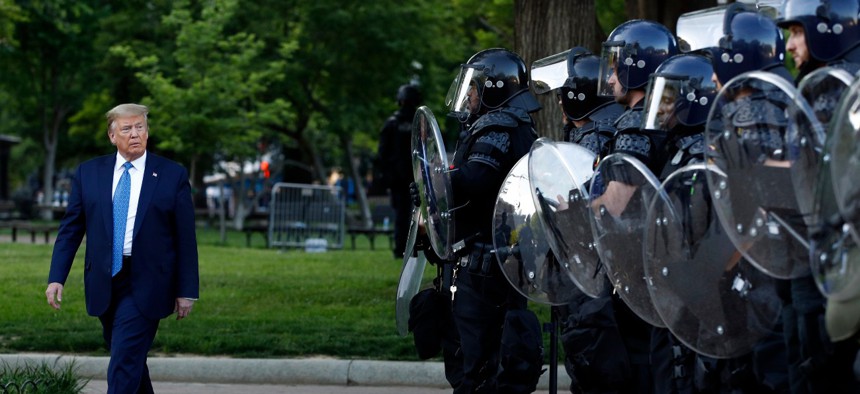Last Year's Crackdown Outside White House Not Directly Tied to Trump's Photo Op, IG Finds
IG declines to rule on whether forceful tactics were appropriate.
At least one of the federal law enforcement agencies involved in the crackdown on protesters outside the White House last year made an operational decision to do so independently of President Trump’s decision to walk through the area for a photo opportunity at a nearby church, according to an inspector general report released on Wednesday.
The U.S. Park Police, a division of the Interior Department, had planned for days to install a fence around Lafayette Park, the area just north of the White House, and planned at least the day before to clear out protestors in order to do so. The exact timing of the installation was not predetermined by USPP and its partners at the Secret Service, the IG said, but only happened to coincide with Trump’s walk through the park because of the timing of the fence’s arrival from a contractor. The protests had carried on for several days following the police killing of George Floyd and before Trump’s photo op on June 1.
The forceful tactics and deployment of chemical irritants on protesters by federal and local law enforcement to disperse crowds immediately before Trump left the White House to take photos holding a Bible in front of St. John's Church, which had sustained damage during the protests, sparked significant backlash and accusations of illegal actions by various agencies. Lawmakers and other observers have speculated that law enforcement’s decision making and timeline was influenced or directly ordered by the White House to allow for the president’s walk, but the Interior IG found no direct connection.
USPP leadership knew of a potential presidential visit in the area prior to its crackdown, the IG said, but it maintained that its decisions were unaffected by that knowledge.
"I can tell you with 100% certainty that the Secret Service and the Park Police ... timeline did not change the entire day,” then-USPP acting Chief of Police Gregory Monahan told the investigators.
Monahan and other federal leaders met with then-Attorney General Bill Barr at 2 p.m. on June 1, just hours before federal officers deployed in Lafayette Park. The plan to disperse the crowd and install the fence later that day was already in motion before that meeting, the IG found, and Barr did not discuss Trump’s movement at that point. Law enforcement officials had decided days earlier the protection of federal property and personnel necessitated the installation of a fence, the IG said, and that it had to clear out protesters in order to safely set it up.
Barr himself appeared in Lafayette Park prior to Trump, which the IG also found had no bearing on law enforcement actions. While there, Barr notified the USPP incident commander for the first time Trump was soon going to appear. The Park Police official told the IG he responded, "Are you freaking kidding me?" before hanging his head and walking away. Still, the IG maintained the conversation had no impact on operational decision making.
"The evidence established that relevant USPP officials had made those decisions and had begun implementing the operational plan several hours before they knew of a potential presidential visit to the park, which occurred later that day," said Mark Greenblatt, the Interior IG. "As such, we determined that the evidence did not support a finding that the USPP cleared the park on June 1, 2020, so that then President Trump could enter the park."
The IG did not investigate the appropriateness of the USPP’s decision making on June 1, but noted it did not violate any statutes or regulations. Critics have decried its deployment less than an hour before a 7 p.m. curfew instituted by Mayor Muriel Bowser, D-D.C., was set to go into effect, but the investigators noted the federal agency faced no obligation to conform to that timeline. The IG faulted USPP for failing to maintain clear communication between agencies and said it needed a clearer policy on when and how to notify protesters to disperse. Park Police used speakers to send dispersal messages before they deployed, but they were widely considered ineffective and inaudible to much of the crowd.
The Secret Service appeared to operate on a separate timeline despite its close coordination with USPP, sending in officers before dispersal messages were broadcast. That decision escalated tensions and caught Park Police by surprise, the IG noted, causing Secret Service to later apologize to its law enforcement partners.
The IG also cleared Park Police of using CS gas, finding that only Washington’s Metropolitan Police Department had done so. Bureau of Prisons personnel deployed pepper balls, which ran counter to direct instructions from the USPP incident commander. The Interior IG deferred any action on that activity to the Justice Department.
Greenblatt noted that individual use-of-force incidents are subject to other ongoing IG investigations, as well as lawsuits.








